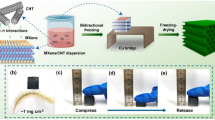Abstract
In this paper, the covalently bonded polyaniline (PANI) nanofiber/multi-walled carbon nanotubes (MWCNT) composites were synthesized via interfacial polymerization of aniline with para-phenylenediamine functionalized MWCNT at the interface of oil/water system. Owing to the diffusion-controlled growth process of PANI, PANI with uniform fiber structure were obtained. The morphology analysis showed that the diameter of PANI nanofiber decreased with the increasing of MWCNT loading amount. Impedance analysis showed that the charge-transfer resistances of the composites were reduced also with the increasing of MWCNT loading amount. The decreasing of charge-transfer resistances and change of morphology resulted in enhanced capacitive properties. Electrochemical tests showed that the specific capacitance of PANI, PANI/MWCNT-10% and PANI/MWCNT-20% were 405, 641 and 764 F·g-1, respectively. As comparison with pure PANI nanofiber, the specific capacitance of the composites increased by 58% and 88.6%, respectively.






Similar content being viewed by others
References
Bogue R (2013) Powering tomorrow's sensor: a review of technologies – Part 1. Sens. Rev. 30:271–275
Vangari M, Pryor T, Jiang L (2013) Supercapacitors: Review of Materials and Fabrication Methods. Journal of Energy Engineering 139:72–79
Kandasamy SK, Kandasamy K (2018) Recent Advances in Electrochemical Performances of Graphene Composite (Graphene-Polyaniline/Polypyrrole/Activated Carbon/Carbon Nanotube) Electrode Materials for Supercapacitor: A Review. Journal of Inorganic & Organometallic Polymers & Materials:1–26
Salunkhe RR, Lin J, Malgras V et al (2015) Large-scale synthesis of coaxial carbon nanotube/Ni (OH)2 composites for asymmetric supercapacitor application. Nano Energy 11:211–218
Tang J, Salunkhe RR, Liu J et al (2015) Thermal Conversion of Core–Shell Metal–Organic Frameworks: A New Method for Selectively Functionalized Nanoporous Hybrid Carbon. J. Am. Chem. Soc. 137:1572
Salunkhe RR, Tang J, Kamachi Y et al (2015) Asymmetric Supercapacitors Using 3D Nanoporous Carbon and Cobalt Oxide Electrodes Synthesized from a Single Metal–Organic Framework. Acs Nano 9:6288–6296
Wang Y, Guo J, Wang T et al (2015) Mesoporous Transition Metal Oxides for Supercapacitors. Nanomaterials 5:1667–1689
Meng Q, Cai K, Chen Y et al (2017) Research progress on conducting polymer based supercapacitor electrode materials. Nano Energy 36
Snook GA, Kao P, Best AS (2011) Conducting-polymer-based supercapacitor devices and electrodes. J. Power Sources 196:1–12
Bélanger D, Ren X, Davey J et al (2000) Characterization and Long-Term Performance of Polyaniline-Based Electrochemical Capacitors. J. Electrochem. Soc. 147:2923–2929
Xiong S, Yang F, Jiang H et al (2012) Covalently bonded polyaniline/fullerene hybrids with coral-like morphology for high-performance supercapacitor. Electrochim. Acta 85:235–242
Xiong S, Shi Y, Jia C et al (2014) Preparation of High-performance Covalently Bonded Polyaniline Nanorods/Graphene Supercapacitor Electrode Materials using Interfacial Copolymerization Approach. Electrochim. Acta 127:139–145
Zhang X, Meng X, Wang Q et al (2018) Preparation and electrochemical investigation of polyaniline nanowires for high performance supercapacitor. Mater. Lett. 217:312–315
Pang S, Chen W, Yang Z et al (2017) Facile Synthesis of Polyaniline Nanotubes with Square Capillary Using Urea as Template. Polymers 9:510
Zhou SX, Tao XY, Ma J et al (2017) Facile synthesis of self-assembled polyaniline nanorods doped with sulphuric acid for high-performance supercapacitors. Vacuum 143
Roy A, Ray A, Saha S et al (2018) Investigation on energy storage and conversion properties of multifunctional PANI-MWCNT composite. Int. J. Hydrogen Energy 43
Frackowiak E, Béguin F (2001) Carbon materials for the electrochemical storage of energy in capacitors. Carbon 39:937–950
He X, Liu G, Yan B et al (2016) Significant enhancement of electrochemical behaviour by incorporation of carboxyl group functionalized carbon nanotubes into polyaniline based supercapacitor. Eur. Polym. J. 83:53–59
Otrokhov G, Pankratov D, Shumakovich G et al (2014) Enzymatic synthesis of polyaniline/multi-walled carbon nanotube composite with core shell structure and its electrochemical characterization for supercapacitor application. Electrochim. Acta 123:151–157
Male U, Bo KS, Huh DS (2017) Synthesis and characterization of polyaniline-grafted CNT as electrode materials for supercapacitors. Macromolecular Research 25:1–8
Du P, Lin L, Wang H et al (2017) Fabrication of porous polyaniline modified MWNTs core-shell structure for high performance supercapacitors with high rate capability. Materials & Design 127:76–83
Ramana GV, Srikanth VVSS, Padya B et al (2014) Carbon nanotube–polyaniline nanotube core–shell structures for electrochemical applications. Eur. Polym. J. 57:137–142
Xiong S, Wei J, Jia P et al (2011) Water-processable polyaniline with covalently bonded single-walled carbon nanotubes: enhanced electrochromic properties and impedance analysis. Acs Applied Materials & Interfaces 3:782
Xiong S, Yang F, Ding G et al (2012) Covalent bonding of polyaniline on fullerene: Enhanced electrical, ionic conductivities and electrochromic performances. Electrochim. Acta 67:194–200
Peikertová P, Kulhánková L, Neuwirthová L et al (2016) Raman study of PANI thin film during long time period in dependence on storage conditions. Chemical Papers 71:379–385. https://doi.org/10.1007/s11696-016-0078-3
Liu MC, Kong LB, Lu C et al (2012) Waste paper based activated carbon monolith as electrode materials for high performance electric double-layer capacitors. RSC Adv. 2:1890–1896
Lin K-M, Chang K-H, Hu C-C et al (2009) Mesoporous RuO2 for the next generation supercapacitors with an ultrahigh power density. Electrochim. Acta 54:4574–4581. https://doi.org/10.1016/j.electacta.2009.03.058
Chang WM, Wang CC, Chen CY (2016) Plasma-Induced Polyaniline Grafted on Carbon Nanotube-embedded Carbon Nanofibers for High-Performance Supercapacitors. Electrochim. Acta 212:130–140. https://doi.org/10.1016/j.electacta.2016.06.159
Acknowledgments
This work was supported by Opening Project of Guangxi Key Laboratory of Calcium Carbonate Resources Comprehensive Utilization (HZXYKFKT201804) and Natural Science Foundation of Shaanxi Province, China (2018JM5027).
Author information
Authors and Affiliations
Corresponding author
Additional information
Publisher’s note
Springer Nature remains neutral with regard to jurisdictional claims in published maps and institutional affiliations.
Rights and permissions
About this article
Cite this article
Xiong, S., Zhang, X., Wang, R. et al. Preparation of covalently bonded polyaniline nanofibers/carbon nanotubes supercapacitor electrode materials using interfacial polymerization approach. J Polym Res 26, 90 (2019). https://doi.org/10.1007/s10965-019-1749-x
Received:
Accepted:
Published:
DOI: https://doi.org/10.1007/s10965-019-1749-x




